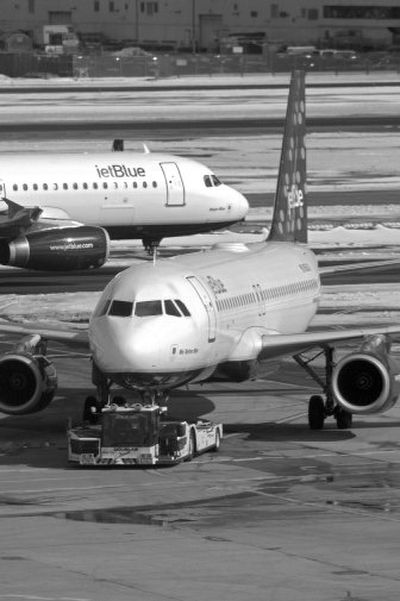JFK JetBlue terminal finds some calm after storm

NEW YORK – The six-day siege of angry and disgruntled travelers at JetBlue’s Kennedy airport terminal appeared to ease Monday as service desks functioned more smoothly and customer calm prevailed despite a new spate of flight cancellations.
The beleaguered company said it was canceling almost a quarter of its flights Monday but hoped to restore full operations today, almost a week after a Valentine’s Day snowstorm created a travel meltdown that virtually paralyzed JetBlue Airways Corp.
David G. Neeleman, the company’s founder and chief executive, told the New York Times he was “humiliated and mortified” by the breakdown, which he blamed on several factors besides the weather – poor communications, an overwhelmed reservations system, and many of JetBlue’s 11,000 pilots and flight attendants being stuck in locations other than where they were needed. Federal aviation rules also limit the number of hours that pilots can fly without rest breaks.
JetBlue spokesman Sebastian White said that Monday’s cancellations helped make sure all flight crews had legally mandated amounts of rest before flying again and gave the airline the time to get equipment to the proper places. He said planes were being repositioned Monday afternoon to be ready to go this morning.
While JetBlue was making its own analysis, one travel expert suggested the airline had brought the crisis on itself by trying to do the right thing for its passengers despite the wintry weather threat.
“Most airlines don’t try to operate when there is an ice storm problem – they’ve learned that it’s better to cancel all flights at the outset and then try to get back to normal operations as quickly as possible,” David Stempler, president of the Washington, D.C.-based, member-supported Air Travelers Association, told the Associated Press on Monday.
On Monday morning, Dawn Colonese, of New Haven, Conn., arrived at JFK with her husband and two daughters – on their way, they hoped, for a Florida vacation.
Trying on Sunday to confirm the flight, Colonese said she first got a recorded message saying the system was overloaded; then was disconnected. Finally she was able to record a complaint, and an apologetic airline representative returned her call five hours later.
Even though the terminal was orderly Monday, Colonese said that based on what had happened, “I don’t think I would fly with JetBlue again.”
The crisis, which centered around the popular cut-rate airline’s New York hub, was old news to some passengers arriving from other cities.
“It’s not that big a deal,” said Lily Gilbert, of Eugene, Ore., who said her flight from Portland to JFK was only slightly delayed.
Some, like Sarah King, a Connecticut resident returning from Portland, said she didn’t think the weeklong debacle would hurt JetBlue in the long run.
“I think they offer a unique service. … We’ll definitely fly them again,” King said while waiting to leave the terminal, from which reporters and TV news crews had been banned by JetBlue officials.
Apologies had been the order of the day – the week, in fact – for JetBlue.
JetBlue sent departing flights out to anti-icing stations where they waited for takeoff clearance, while incoming flights parked at the terminal and could not be moved as the storm worsened. That left the departing aircraft, filled with passengers, trapped – unable to return and unable to take off – for hours.
Stempler also said the fast growth of some airlines, such as JetBlue, can create demands that are beyond their capability, especially in a crisis.
“JetBlue tried to do their best – tried to keep the system rolling,” he said. “Their heart was in the right place, but their head was not.”
White said JetBlue has tried to reduce the backlog of passengers by using charter flights, adding flights in certain sectors, rebooking passengers to later dates, and booking seats on other airlines.